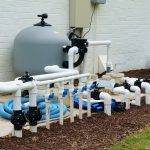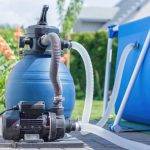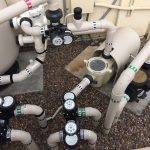Which pool pump should I buy?
Your swimming pool’s pump is responsible for moving water through your plumbing, filter, and any other features your pool may have. These features can include spa jets, waterfalls, in-floor cleaning systems, connected hot tubs, and heaters. When purchasing a pump, there are several choices you’ll have to consider for your pool’s specific needs.
Should I choose a single speed, two speed, or variable speed pump?
On July 19, 2021, the US Department of Energy implemented Federal Energy Efficiency regulations on swimming pool pumps. Since those regulations were introduced, almost all pool pumps above 1.1 total horsepower (THP) are variable speed pumps. There are some exceptions at lower THP, and if you are outside of the United States then single speed or two speed pumps may still be available.
Variable speed pumps are the best choice for most swimming pools for multiple reasons:
- You can adjust the speed to suit your filter, plumbing, and water features. Running at too high a speed (and thus too high a flow rate) can damage your filter or other features, but with a variable speed pump you can dial in the speed to your exact needs. Plus, with multiple water features in your pool, you can have a setting catered to using those features and a separate setting for general filtration and circulation.
- Running a pump at lower speeds uses less energy and thus costs much less despite the longer run times necessary for sufficient circulation. At lower speeds, they also generate much less noise!
- Some variable speed pumps are compatible with pool automation systems, making them even easier to use efficiently. Check manufacturer websites to ensure the controller for your variable speed pump is compatible with your desired automation system.
Some single speed pumps are compliant with the aforementioned DOE regulations, but even then they are not available in all states due to separate state level regulations. These single speed pumps may be cheaper and simpler for above ground pools or as dedicated pumps for water features.
Should I choose a high head pump, a medium head pump, or a low head pump?
For an in-ground pool, you should stick with a high or medium head pump. Your choice of high vs. medium head pump depends on the number of water features you have, the length of your plumbing (i.e. how far away your equipment pad is from your pool), and the size of your plumbing (1 ½ inch pipes vs. 2 inch pipes). If you have multiple of these features and/or lots of turns in your 2” plumbing, you should consider a high head pump. If your pool only has a filter, salt water chlorine generator, and maybe a heater, choose a medium head pump.
Low head pumps, sometimes labeled as “water feature pumps”, can be used for above-ground pools due to their minimal plumbing and basic skimmer-filter-return setup.
How much horsepower should my pump have?
Manufacturers typically don’t label their pumps based on their “head” but will provide their pumps’ total horsepower. Their pump product lines are generally arranged as follows:
- ~3 THP variable speed pumps are typically high head pumps suitable for pools with heaters, spa jets, in-floor cleaning systems, or other features
- ~1.5 THP variable speed pumps are typically medium head pumps for basic in-ground pools
- ~1.0 THP variable speed or single speed pumps are typically low head pumps for water features or above-ground pools.
In general, we recommend going for a higher ~3 THP pump because the speed can always be adjusted to give you the flow that you want, and running at lower speeds can produce considerable energy savings over time.
What about turnover rate?
Turnover rate is the amount of time that a pump takes to circulate your pool’s entire water volume once. However, TFP doesn’t recommend using turnover rate to choose a pump for your swimming pool. The main reasons to run your pool pump are to skim and filter your pool, to generate chlorine with your salt water chlorine generator, and to mix any chemical additions into your water. Chasing a faster turnover rate can cause you to run your pump faster than what is necessary, compromising the energy savings that a variable speed pump can offer. Read more about the problems of chasing turnovers here.
What brand of pool pump should I choose?
Essentially, all pool pumps are the same in that they move water through your pool. If your pool doesn’t have many specific requirements, water features, or an automation system, choose a lower cost pump that is disposable when it fails.
Pentair, Hayward, and Jandy are the “big three” pool equipment manufacturers. They offer you support and warranties if you purchase from authorized dealers and can ensure compatibility with their automation systems. Their warranties may be dependent on installation from an authorized technician. They have multiple pump families with various features and horsepowers for every price point.
Waterway, Circupool, Black & Decker, and others have variable speed pool pumps with basic features and may even offer rudimentary automation interfaces. These pumps are at a lower price point than the major manufactures and can be attractive to the DIY pool owner who does not care about brand names or warranties.
How long should I run my pool pump each day?
This article in Pool School will help you determine pump run time based on your pool’s needs.





